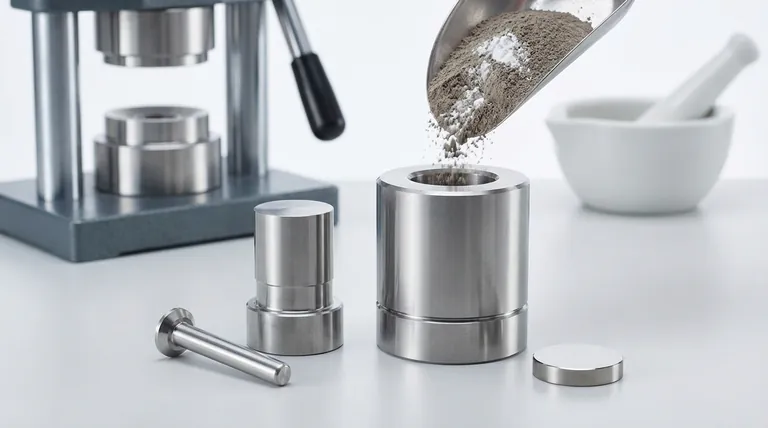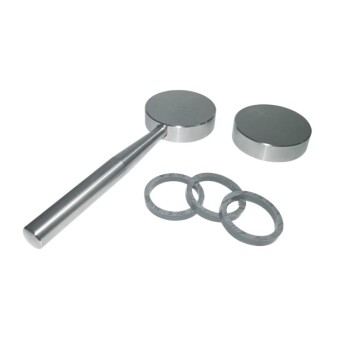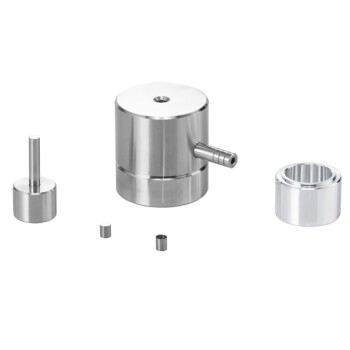To make an XRF pellet, you must execute a precise, four-step process. This involves grinding the sample into a very fine powder, thoroughly mixing it with a binding agent, loading this mixture into a pellet die, and finally, compressing it under high pressure (typically 15 to 40 tons) to form a solid, stable tablet for analysis.
The ultimate goal of making a pressed pellet is not just to create a solid sample, but to produce a perfectly homogeneous and flat analytical surface. The quality of your XRF data is directly dependent on the quality of your sample preparation.

The Four-Step Process for an Analytical Pellet
Achieving accurate and repeatable XRF results hinges on mastering each stage of the pellet-making process. Each step is designed to eliminate a specific source of analytical error.
Step 1: Grinding the Sample
The first and most critical step is reducing your sample to a fine, uniform powder. The goal is to create particles of a consistent and small size.
This is done to minimize what is known as particle size effects, where larger or inconsistently sized particles can absorb and scatter X-rays differently, skewing your results.
Step 2: Adding and Mixing a Binder
Once ground, the sample powder is mixed with a specialized binder or grinding aid. These are typically waxes or cellulosic materials.
The binder serves two purposes: it helps the sample particles stick together during compression, and it can act as a lubricant during grinding to prevent clumping.
Step 3: Loading the Pellet Die
The powder-binder mixture is then carefully poured into a high-strength steel cylinder known as a pellet die.
Ensuring the mixture is evenly distributed within the die is crucial for creating a pellet with uniform density and preventing cracks during compression.
Step 4: Compressing the Sample
Finally, the loaded die is placed into a hydraulic press. A significant pressure, typically between 15 and 35 tons, is applied.
This immense force compacts the powder into a dense, solid, and durable pellet with a smooth surface that is ideal for XRF analysis. The resulting tablet is then ready for the spectrometer.
Why Pellet Quality is Critical for XRF Analysis
A poorly prepared pellet will inevitably produce unreliable data. Understanding the "why" behind the process ensures you avoid the most common pitfalls that compromise analytical integrity.
The Problem of Heterogeneity
The X-ray beam analyzes a relatively small area on the pellet's surface. If that surface is not a perfect representation of the entire bulk sample, your results will be incorrect.
Homogeneity, achieved through fine grinding and thorough mixing, ensures that the analyzed spot is statistically identical to the rest of the sample.
The Impact of Surface Finish
An ideal pellet has a perfectly flat and smooth surface. Any cracks, crumbling edges, or surface imperfections can alter the distance to the X-ray detector and cause inconsistent readings.
The combination of a good binder and correct compression pressure is what creates this required stable and flawless surface.
Common Pitfalls to Avoid
Even with the right equipment, simple errors in the process can invalidate your results. Awareness of these issues is key to producing high-quality pellets every time.
Insufficient Grinding
This is the most common source of error. If particles are too large or varied in size, you will get poor precision and inaccurate elemental readings. Never rush the grinding step.
Incorrect Binder Ratio
Using too much binder can dilute your sample, leading to weaker signal intensity and lower reported concentrations. Using too little will result in a fragile pellet that cracks or crumbles.
Uneven Loading or Compression
If the powder is not loaded evenly in the die, the resulting pellet can have density gradients. Likewise, applying pressure too quickly can trap air and cause the pellet to fracture upon release.
A Checklist for Repeatable Results
To ensure your data is consistently reliable, focus on the fundamental goal behind each step of the process.
- If your primary focus is accuracy: Concentrate on the grinding stage to completely eliminate particle size effects.
- If your primary focus is repeatability: Maintain strict consistency in your process, using the exact same binder ratio, grinding time, and compression pressure for every sample.
- If your primary focus is sample integrity: Ensure your final pellet is durable, free of cracks, and can be handled without contaminating the spectrometer.
Mastering this preparation technique is the foundation for generating XRF data you can trust.
Summary Table:
| Step | Key Action | Purpose |
|---|---|---|
| 1. Grinding | Reduce sample to a fine powder | Eliminate particle size effects for accuracy |
| 2. Mixing Binder | Combine powder with a binding agent | Ensure pellet cohesion and prevent cracking |
| 3. Loading Die | Evenly distribute mixture in a steel die | Create a pellet with uniform density |
| 4. Compression | Apply high pressure (15-35 tons) | Form a solid, flat, and stable analytical surface |
Generate XRF data you can trust with KINTEK.
Mastering sample preparation is the foundation of accurate analysis. Our range of high-quality pellet dies, hydraulic presses, and binding agents are designed to help your laboratory achieve perfect homogeneity and a flawless surface finish every time, ensuring your results are both accurate and repeatable.
Ready to improve your XRF analysis? Contact our lab equipment experts today to find the perfect sample preparation solution for your needs.
Visual Guide

Related Products
- XRF Boric Acid Lab Powder Pellet Pressing Mold for Laboratory Use
- Single Punch Electric Tablet Press Machine Laboratory Powder Tablet Punching TDP Tablet Press
- XRF & KBR plastic ring lab Powder Pellet Pressing Mold for FTIR
- Laboratory Hydraulic Pellet Press for XRF KBR FTIR Lab Applications
- Single Punch Tablet Press Machine and Mass Production Rotary Tablet Punching Machine for TDP
People Also Ask
- What are the samples for XRF analysis? A Guide to Preparing Solids, Powders, and Liquids
- What are the different types of XRF samples? A Guide to Solid, Powder, and Liquid Prep
- What size are XRF pellets? A Guide to Standard Dimensions and Preparation
- What are pellet dies made of? Choose the Right Material for Accurate XRF Analysis
- What equation do you use to calculate the heat required to melt a sample? Master the Heat of Fusion Formula



















